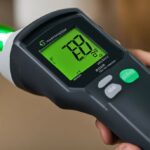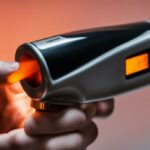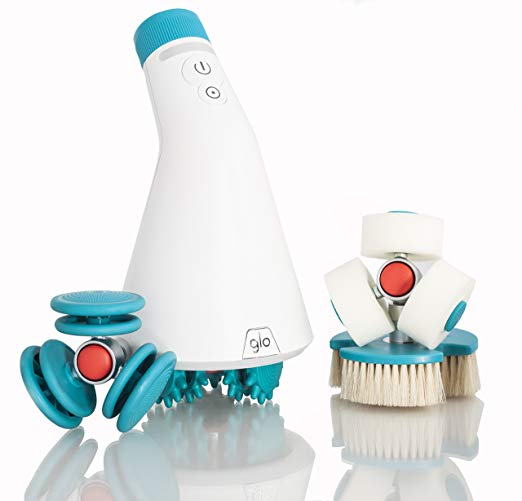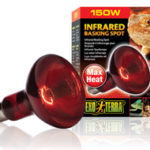Last Updated on 6 months by Francis
When it comes to measuring body temperature, using an infrared thermometer on the forehead has become increasingly popular. Infrared thermometers are non-invasive and easy to use, making them a convenient option for both adults and babies. But what constitutes a normal forehead temperature when using an infrared thermometer? And how accurate are these devices?
The normal range for forehead temperature varies slightly from person to person and can be influenced by factors such as age, physical activity, and environment. However, a temperature reading between 97.5°F (36.4°C) and 99.5°F (37.5°C) is generally considered to be within the normal range.
It’s important to note that infrared thermometers are generally accurate, but certain factors can affect their readings. For example, sweating or wearing a hat may affect the temperature reading. To ensure accuracy, it’s crucial to follow specific guidelines when measuring forehead temperature with an infrared thermometer.
To measure forehead temperature correctly, the device should be held about 1 inch (2-3 centimeters) away from the forehead and aimed at the center. The thermometer should be kept still for the duration of the reading, which typically takes only a few seconds.
Contents
Key Takeaways
- The normal range for forehead temperature with an infrared thermometer is between 97.5°F (36.4°C) and 99.5°F (37.5°C).
- Sweating and wearing a hat may affect the accuracy of infrared thermometer readings.
- To measure forehead temperature correctly, hold the device 1 inch (2-3 centimeters) away from the forehead and aim at the center.
- The thermometer should be kept still for the duration of the reading, which typically takes only a few seconds.
- Regular monitoring of forehead temperature can aid in maintaining overall health.
Understanding Normal Body Temperature
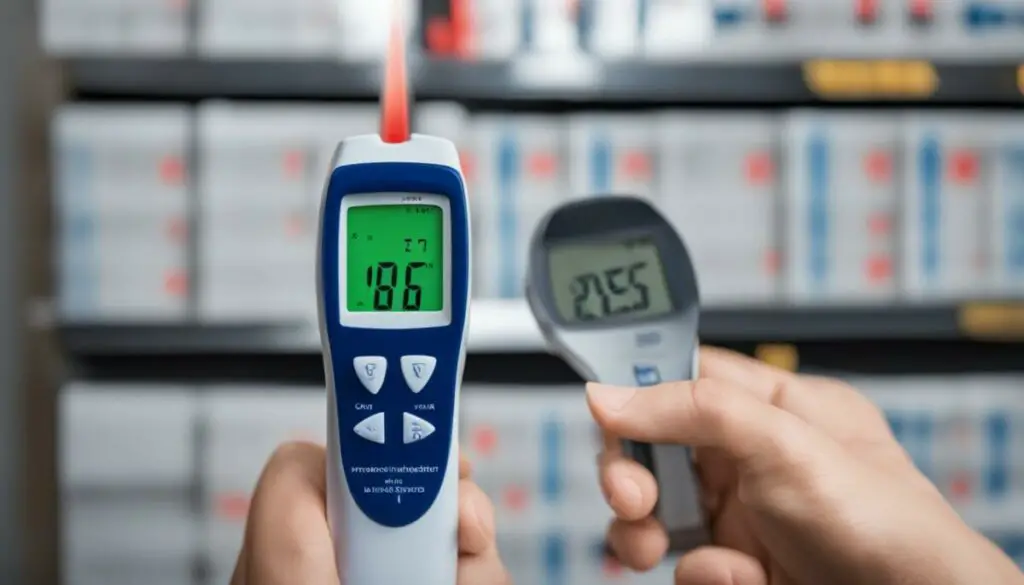
Before we dive into the specific topic of normal forehead temperature, it’s important to have a basic understanding of normal body temperature. The average normal body temperature is generally considered to be around 98.6°F (37°C), although it can vary slightly from person to person.
In fact, research has shown that normal body temperature can range anywhere from 97°F (36.1°C) to 99°F (37.2°C) and still be considered within a healthy range. Factors such as age, gender, physical activity, and time of day can all affect body temperature.
It’s also worth noting that body temperature can fluctuate throughout the day, with the lowest temperature typically occurring in the morning and the highest in the late afternoon or early evening.
In addition to being a useful indicator of overall health, body temperature is also important to monitor when assessing specific health conditions. For example, a fever, which is considered a body temperature above 100.4°F (38°C), can be a sign of infection or illness.
“Normal body temperature can range anywhere from 97°F (36.1°C) to 99°F (37.2°C) and still be considered within a healthy range.”
Factors Affecting Normal Body Temperature
As mentioned, several factors can affect normal body temperature readings. One of the most significant factors is age, with infants and young children typically having higher body temperatures than adults.
Gender can also play a role, with women often having slightly higher body temperatures than men due to hormone fluctuations. Physical activity, ambient temperature, and even emotional state can also influence body temperature.
It’s essential to consider these factors when monitoring body temperature to ensure accurate readings and avoid unnecessary concern.
The Importance of Forehead Temperature Measurement
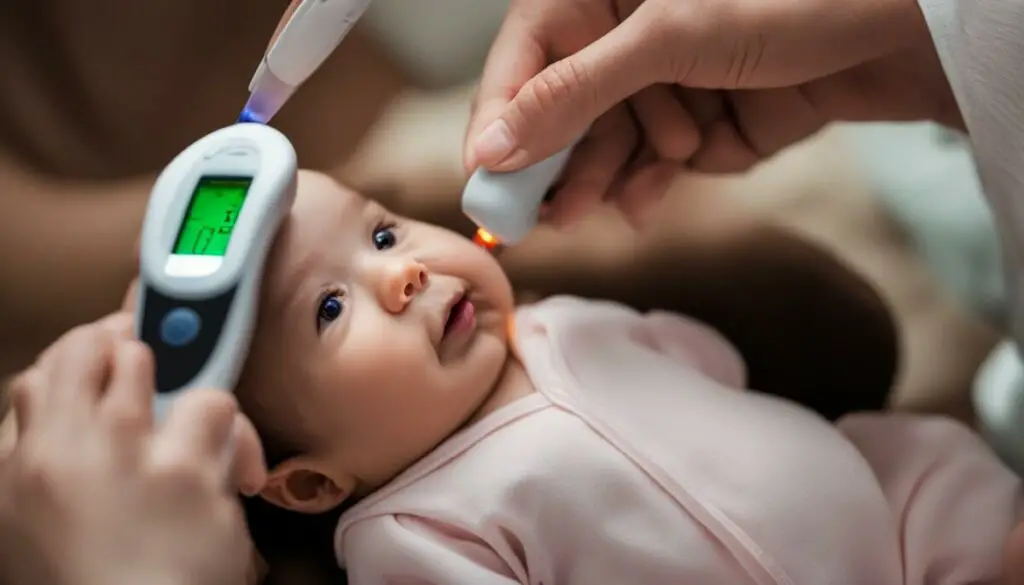
Forehead temperature measurement has become increasingly popular in recent times due to its non-invasive nature and ease of use. This method of temperature measurement uses an infrared thermometer that scans the forehead and provides a reading within seconds. Both adults and babies can benefit from this method of temperature measurement.
For adults, using an infrared thermometer for forehead temperature measurement can be particularly useful in detecting early signs of fever. Given that fever is a common symptom of various illnesses, detecting it early can make a significant difference in managing its progression and preventing further complications.
Similarly, using an infrared thermometer for babies allows for easy temperature monitoring without causing discomfort or distress. Traditional methods of temperature measurement for babies, such as rectal temperature checks, can be both uncomfortable and invasive. Forehead temperature measurement using an infrared thermometer allows for accurate temperature measurement without causing unnecessary discomfort to the baby.
Additionally, forehead temperature measurement can be particularly useful in public settings, where frequent temperature checks can aid in maintaining a safe and healthy environment. For instance, workplaces, schools, and healthcare settings can use infrared thermometers for quick and efficient temperature checks.
Using Infrared Thermometers for Adults and Babies
Infrared thermometers specifically designed for adults and babies are available in the market. While these thermometers function similarly, there are slight variations in their design and specifications. For instance, baby-specific infrared thermometers may have a smaller probe for easier and more accurate measurement of baby’s forehead temperature.
It’s important to carefully read the manufacturer’s instructions before using an infrared thermometer for forehead temperature measurement. This will ensure that accurate readings are obtained while minimizing any discomfort or inconvenience.
Interpreting Forehead Temperature Readings

When using an infrared thermometer to measure forehead temperature, it’s essential to understand what a normal temperature range is and what variations in readings may indicate.
According to the American Academy of Pediatrics, a normal forehead temperature for children and adults is between 97.4°F (36.3°C) and 100.4°F (38°C). However, it’s important to note that normal temperature ranges can vary slightly from person to person and by age group.
Tip: To obtain the most accurate temperature reading, it’s recommended to take multiple measurements and use the average.
When interpreting forehead temperature readings, it’s crucial to consider individual factors that can affect accuracy. Factors such as physical activity, recent food and drink intake, and the environment can all influence forehead temperature readings.
It’s also important to note that certain medical conditions or medications can affect forehead temperature readings. If you suspect that a medical condition or medication is impacting forehead temperature readings, it’s recommended to consult a healthcare professional.
To gain a better understanding of what constitutes a normal temperature range for you, it’s a good idea to take regular forehead temperature measurements over time. This can serve as a baseline and help you identify any potential issues or changes in temperature.
Comparing Forehead Temperature with Other Measurement Methods
Forehead temperature measurement is just one of several methods for assessing body temperature. Other common methods include oral, ear, and underarm temperature measurement.
Compared to oral and underarm measurements, forehead temperature measurement is generally considered more hygienic and less invasive. Ear temperature measurement can be affected by factors such as earwax buildup, while underarm temperature measurement can be influenced by external factors such as clothing and environmental temperature.
It’s important to note that forehead temperature measurements may not always be as accurate as other methods. However, they do provide a convenient and non-invasive option for regular temperature monitoring.
Factors Affecting Forehead Temperature Readings
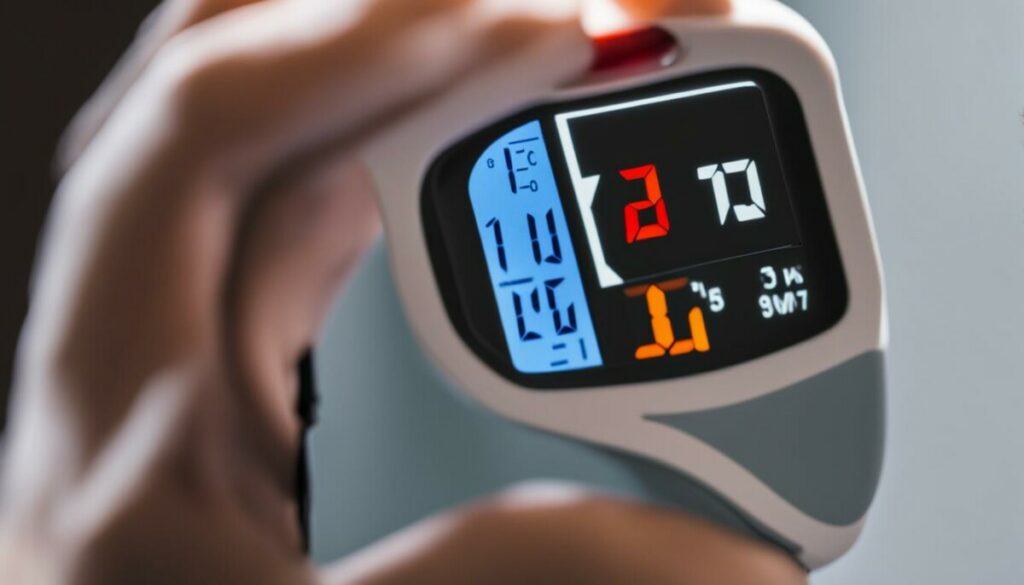
While infrared thermometers are generally accurate, a variety of factors can influence their readings. It’s essential to take these factors into account to ensure accurate and consistent measurements.
Room Temperature
The ambient temperature of the room in which you are taking the measurement can affect readings. If the temperature is too low, the thermometer may give lower readings, while if the temperature is too high, the thermometer may give higher readings. It’s best to take measurements in a room with a stable temperature between 60-71°F (15.6-21.7°C).
Sweating
If the individual whose temperature is being measured has been sweating, it’s best to wait for a few minutes before taking the measurement. Sweat can cool the forehead and cause inaccurate readings.
Hair
If the individual has hair covering their forehead, it’s important to move the hair aside or use a forehead cover to ensure accurate measurement.
Movement
Movement, exercise, or physical activity can all affect forehead temperature readings. It’s best to wait for at least 10 minutes after exercise before taking a measurement.
Distance and Angle
The distance and angle of the infrared thermometer from the forehead can also affect readings. It’s important to follow the manufacturer’s instructions regarding the correct measurements distance (usually 1-2 inches away) and angle (usually perpendicular to the forehead).
Tip: It’s a good practice to take multiple readings, and average them for the most accurate result.
Guidelines for Taking Forehead Temperature

Accurate measurement of forehead temperature with an infrared thermometer requires proper technique and positioning. Follow these guidelines to ensure accurate readings:
- Preparation: Before taking a forehead temperature, make sure the person has not consumed any hot or cold fluids within the previous 15 minutes, and that they have not engaged in any physical activity that may affect their temperature. Additionally, make sure the infrared thermometer has accurate calibration, and check the battery level. Refer to the manufacturer’s guidelines for specific instructions.
- Positioning: Position the thermometer at the center of the forehead, midway between the eyebrows and hairline. Hold the thermometer perpendicular to the forehead and keep it in place for the duration recommended by the manufacturer. Avoid touching the forehead or any other surface with the thermometer.
- Interpretation: Once the forehead temperature is displayed on the thermometer, compare it to the normal temperature range. If the temperature is outside the normal range, take a second reading after waiting for a few minutes. If the second reading is also abnormal, consider consulting a medical professional.
Following these guidelines will ensure accurate and reliable forehead temperature readings. Remember that proper technique is especially important when taking forehead temperature in infants and children, as they may be more sensitive to temperature variations.
Adjusting for Age and Other Factors
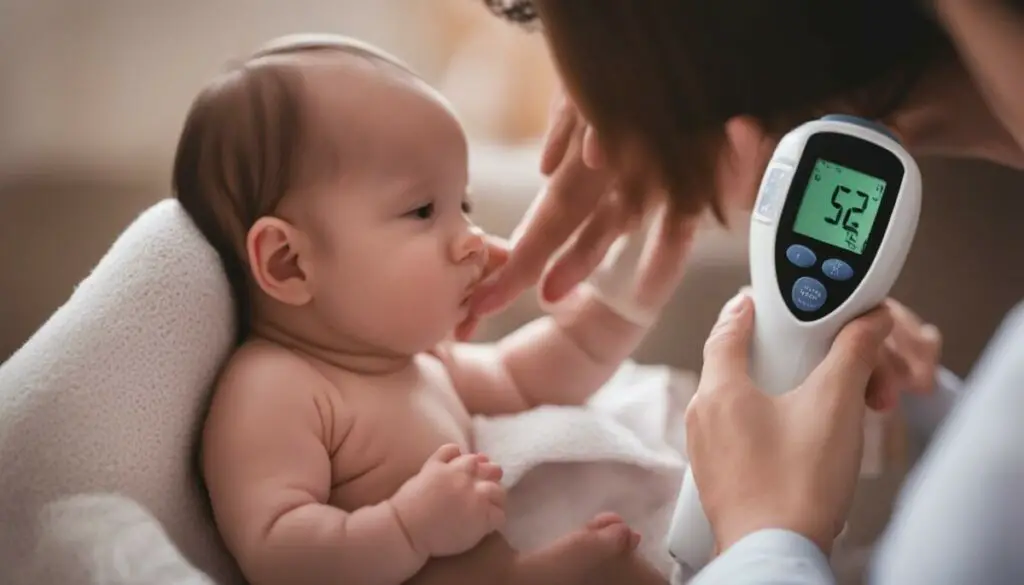
When using an infrared thermometer for forehead temperature measurement, it’s important to consider the age of the person being measured. Normal forehead temperature ranges can vary slightly between age groups. For adults, a normal range is typically between 97°F (36.1°C) and 99°F (37.2°C), while for babies and young children, a normal range can be slightly higher, averaging between 97.9°F (36.6°C) and 100.4°F (38°C).
In addition to age, certain factors can also affect forehead temperature readings. Physical activity, such as exercise or exertion, can temporarily raise forehead temperature. Similarly, environmental factors like sun exposure or a warm room can also influence readings.
When measuring forehead temperature with an infrared thermometer, it’s important to account for these factors. Wait until the person being measured has been at rest in a room temperature environment for at least 10 minutes. If the person has been active or exposed to sunlight, it’s recommended to wait for at least 20 minutes before taking the measurement.
It’s also important to note that infrared thermometers for adults should not be used on babies under three months old. For babies, use a thermometer designed specifically for infant use, or consult a healthcare provider for guidance.
Forehead Temperature Monitoring for Health Maintenance

Regular monitoring of forehead temperature can be a valuable tool in maintaining overall health. By using an infrared thermometer for ongoing temperature checks, you can catch any changes early and take appropriate action.
For adults, a normal forehead temperature range is typically between 97.2°F to 99.5°F. For babies, a normal range can be slightly higher, usually between 97.9°F to 100.4°F. By regularly monitoring temperature and noting any unusual fluctuations, you can detect early signs of illness and take steps to prevent further complications.
One of the benefits of using an infrared thermometer for forehead temperature monitoring is its ease of use. It’s non-invasive and can be taken at any time without disturbing sleep or daily routines. Additionally, infrared thermometers provide a quick reading, saving time and effort.
It’s important to note that if you or your child experiences persistently high forehead temperature readings, it may be indicative of an underlying health issue that requires medical attention.
By following proper measurement guidelines and keeping track of forehead temperature readings over time, you can gain valuable insights into your overall health and take steps to maintain optimal well-being.
Comparing Forehead Temperature with Other Measurement Methods
While forehead temperature measurement is convenient and non-invasive, it’s important to understand how it compares to other measurement methods. Comparing forehead temperature readings to measurements taken through the mouth, ear, and underarm can help determine the most appropriate method to use for different age groups and situations.
Normal body temperature: The average normal body temperature for adults is 98.6°F (37°C). However, normal body temperature can vary between individuals and can also be affected by factors such as age, gender, and time of day.
| Method | Accuracy | Advantages | Disadvantages |
|---|---|---|---|
| Forehead | Accurate when used correctly | Non-invasive, easy to use | May be affected by sweat or hair, not suitable for newborns |
| Mouth | Accurate when used correctly | Convenient, suitable for older children and adults | May be affected by drinking or eating, not suitable for young children or individuals with breathing difficulties |
| Ear | Accurate when used correctly | Quick, suitable for all age groups | May require positioning of the ear probe, not suitable for individuals with ear infections or earwax buildup |
| Underarm | Less accurate | Non-invasive, suitable for infants and young children | May be affected by clothing or movement, takes longer to obtain a reading |
As shown in the table above, forehead temperature measurement is accurate when used correctly and offers the advantages of being non-invasive and easy to use. However, it may be affected by sweat or hair and is not suitable for newborns. Mouth and ear measurements offer good accuracy and are suitable for older children and adults, while underarm measurements are less accurate but are non-invasive and suitable for infants and young children.
Conclusion
Measuring forehead temperature with an infrared thermometer has become increasingly popular due to its non-invasive nature and ease of use. To ensure accurate readings, it’s important to follow proper measurement guidelines and consider individual factors that may affect temperatures.
Monitor Health with Regular Forehead Temperature Measurements
By regularly monitoring forehead temperature, individuals can aid in maintaining overall health. Infrared thermometers provide accurate and valuable temperature readings that can help detect changes in body temperature that may indicate an illness.
Compare Forehead Temperature to Other Measurement Methods
While forehead temperature measurement is convenient, it’s important to understand how it compares to other measurement methods. For example, readings taken through the mouth, ear, and underarm can provide different temperature values. However, forehead temperature measurement is the most accessible, non-invasive, and can be used in a variety of settings.
Ensure Accurate Forehead Temperature Readings
Factors such as physical activity, environment, and age can affect forehead temperature readings. To ensure accurate readings, it’s important to follow proper measurement guidelines, such as proper positioning and preparation.
Overall, infrared thermometers provide a valuable tool for measuring forehead temperature accurately and conveniently. By understanding what constitutes a normal forehead temperature and following correct measurement guidelines, individuals can monitor their health and stay proactive in maintaining overall wellbeing.
FAQ
What is the normal forehead temperature range with an infrared thermometer?
The normal forehead temperature range with an infrared thermometer is typically between 97.5°F (36.4°C) and 99.5°F (37.5°C).
How accurate are infrared thermometers for measuring forehead temperature?
Infrared thermometers are generally accurate for measuring forehead temperature. However, it’s important to note that factors such as ambient temperature and user error can affect the accuracy of readings.
How do I measure forehead temperature correctly with an infrared thermometer?
To measure forehead temperature correctly with an infrared thermometer, ensure that the device is held at a distance of about 1-2 inches from the forehead. Aim the thermometer at the center of the forehead and wait for the reading to stabilize.
What is the importance of forehead temperature measurement using an infrared thermometer?
Forehead temperature measurement using an infrared thermometer is important as it provides a non-invasive and convenient way to monitor body temperature. This method is especially useful for adults and babies.
How should I interpret forehead temperature readings obtained with an infrared thermometer?
The normal temperature range with an infrared thermometer for most individuals is between 97.5°F (36.4°C) and 99.5°F (37.5°C). However, it’s essential to consider individual variations and consult a healthcare professional if there are concerns.
What factors can affect forehead temperature readings with an infrared thermometer?
Factors such as sweating, physical activity, and environmental temperature can influence forehead temperature readings obtained with an infrared thermometer. It’s important to take these factors into account and consider adjusting for them if necessary.
How do I ensure accurate forehead temperature measurements with an infrared thermometer?
To ensure accurate forehead temperature measurements with an infrared thermometer, make sure the forehead is clean and dry before taking the reading. Avoid taking measurements immediately after physical activity or exposure to extreme temperatures.
Do normal forehead temperature ranges differ for different age groups?
Slightly different normal forehead temperature ranges may apply to different age groups. It’s important to refer to age-specific guidelines or consult a healthcare professional for accurate interpretation of forehead temperature readings.
Can regular monitoring of forehead temperature aid in health maintenance?
Yes, regular monitoring of forehead temperature can help in maintaining overall health. By keeping track of temperature changes, you can identify potential health concerns and take appropriate action if needed.
How does forehead temperature measurement using an infrared thermometer compare to other methods?
Forehead temperature measurement using an infrared thermometer offers a convenient and non-invasive alternative to other methods such as oral, ear, or underarm measurements. However, it’s important to note that different methods may yield slightly different readings.


